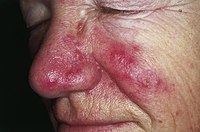
Photo from wikipedia
When applied topically, oxymetazoline and brimonidine reduce the persistent facial erythema of rosacea; this effect is mediated by cutaneous vasoconstriction induced by postsynaptic activation of α‐adrenoceptors. We investigated the α‐adrenergic… Click to show full abstract
When applied topically, oxymetazoline and brimonidine reduce the persistent facial erythema of rosacea; this effect is mediated by cutaneous vasoconstriction induced by postsynaptic activation of α‐adrenoceptors. We investigated the α‐adrenergic pharmacology of oxymetazoline and brimonidine. Functional activity on α‐adrenoceptors was evaluated in vitro in HEK293 cells stably expressing single receptor subtypes using a fluorometric imaging plate reader Ca2+ influx assay. Oxymetazoline was an α1‐adrenoceptor agonist with partial α2‐adrenoceptor activity, whereas brimonidine was a highly selective full α2‐adrenoceptor agonist. In vivo pharmacology was investigated in a mouse model of ultraviolet B light (UVB)‐induced skin erythema. To selectively inhibit α‐adrenoceptor subtypes, mice were injected with prazosin (an α1‐selective antagonist) or rauwolscine (an α2‐selective antagonist) following UVB exposure. Oxymetazoline cream 1.0%, brimonidine gel 0.33% or vehicle control was applied topically, and erythema was measured using a chromameter. Oxymetazoline and brimonidine reduced UVB–induced erythema compared with vehicle control (P < .01). The effect of oxymetazoline was impaired in prazosin‐pretreated but not rauwolscine‐pretreated mice. Conversely, the effect of brimonidine was impaired in rauwolscine‐pretreated but not prazosin‐pretreated mice. These data suggest that while oxymetazoline and brimonidine produce cutaneous vasoconstriction, they do so through different α‐adrenergic mechanisms, with oxymetazoline primarily acting via α1‐adrenoceptors and brimonidine acting via α2‐adrenoceptors.
Journal Title: Experimental Dermatology
Year Published: 2018
Link to full text (if available)
Share on Social Media: Sign Up to like & get
recommendations!